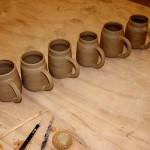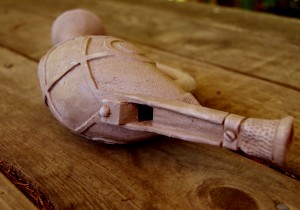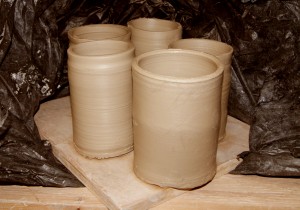Those of you who know me understand that just about any scrap of paper that happens to be laying around is subject to becoming a canvas for some sort of sketch. I find sketches everywhere…particularly in margins of notes from meetings that I attend (no offense to those who are running meetings, but I don’t take that many notes, it just appears that way). For the next few months, however, all that sketching energy is focused on just two sketchbooks, one for The Sketchbook Project and one for my clay class. There are some differences that I am discovering.
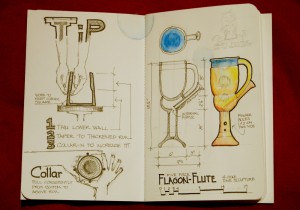 My clay class sketchbook is filling up with project ideas faster than I can wedge clay to even get started. They may be some of my best technical sketches…often looking like details from a set of architectural drawings (imagine that). I have to show great restraint from tackling a project from my sketches because most have little application to the pieces required to satisfy the syllabus. I also know that only one other person must view this sketchbook and that the instructor’s view is more of a formality than a critical view of the contents. Still, this one is filling up and energizing the suppressed, wheel-addicted potter within…and new projects are emerging from the clay in spite of the syllabus.
My clay class sketchbook is filling up with project ideas faster than I can wedge clay to even get started. They may be some of my best technical sketches…often looking like details from a set of architectural drawings (imagine that). I have to show great restraint from tackling a project from my sketches because most have little application to the pieces required to satisfy the syllabus. I also know that only one other person must view this sketchbook and that the instructor’s view is more of a formality than a critical view of the contents. Still, this one is filling up and energizing the suppressed, wheel-addicted potter within…and new projects are emerging from the clay in spite of the syllabus.
On the other hand, The Sketchbook Project seems to be stalled in concerns over the very paper that is bound between its Moleskin covers. The paper provided does not play nice with watercolor or ink wash and I haven’t forced myself to replace it with something that will. Now remember, that ANY paper laying around has been sufficient in the past…and now this odd circumstance (my stubbornness to use watercolor pencil) is producing a backlog of sketches relegated to tracing paper, begging for a place to land. But here is the kicker…this project will be viewed by the general public on a nationwide tour and I think that actually scares me a little. My original objective for participating in The Sketchbook Project was to use the visual stimuli to overcome inertia from novel writing. Now, the inertia of novel writing collides with the inertia of a silly paper quality conundrum, that is stalled due to some irrational fear that someone might actually see that drawings that are intended to release creative energy…whoa boy, is that ever messed up!
I recommend the sketchbook process to anyone who works through creative processes that are heavy on the visual and analytical. There are personal reflection qualities in the process that would make Peter Senge proud…my thoughts above, for instance. Whatever delivery system you choose, however, just don’t let the paper get in the way.
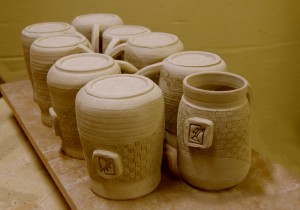 The first batch of wheel-thrown wares that resemble something usable are nearly dry enough for a bisque firing. The bare mug forms from a previous post, now have some surface treatment and the stamp that I use on most of the MugPhlutes. I’m thinking that a dark blue glaze on the interior that caries over to cover the lip area with be the principal color. Red iron oxide will be washed into the textured areas and shadowed lightly below…after that, a simple clear glaze will cover the handle and all of the outside (except for the lip). Three of the mugs will be used to test other glazes. The six that are close enough to call a set will be glazed consistently.
The first batch of wheel-thrown wares that resemble something usable are nearly dry enough for a bisque firing. The bare mug forms from a previous post, now have some surface treatment and the stamp that I use on most of the MugPhlutes. I’m thinking that a dark blue glaze on the interior that caries over to cover the lip area with be the principal color. Red iron oxide will be washed into the textured areas and shadowed lightly below…after that, a simple clear glaze will cover the handle and all of the outside (except for the lip). Three of the mugs will be used to test other glazes. The six that are close enough to call a set will be glazed consistently.
